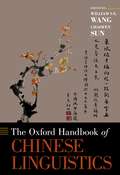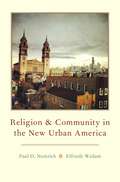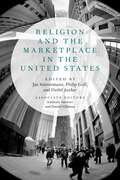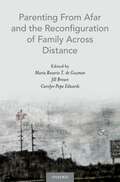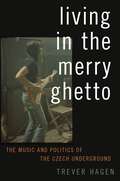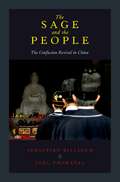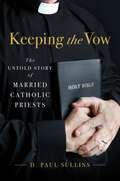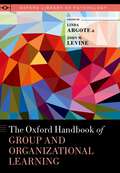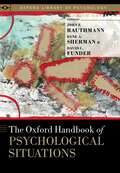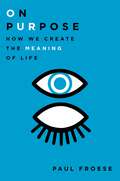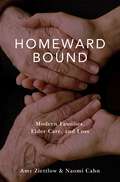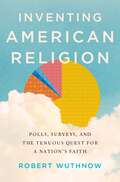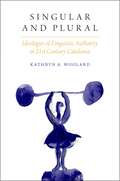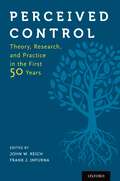- Table View
- List View
CITY A WORLD HISTORY NOWH C: A World History (New Oxford World History)
by Andrew LeesThe City: A World History tells the story of the rise and development of urban centers from ancient times to the twenty-first century. It begins with the establishment of the first cities in the Near East in the fourth millennium BCE, and goes on to examine urban growth in the Indus River Valley in India, as well as Egypt and areas that bordered the Mediterranean Sea. Athens, Alexandria, and Rome stand out both politically and culturally. With the fall of the Roman Empire in the West, European cities entered into a long period of waning and deterioration. But elsewhere, great cities-among them, Constantinople, Baghdad, Chang'an, and Tenochtitlán-thrived. In the late Middle Ages and the Early Modern period, urban growth resumed in Europe, giving rise to cities like Florence, Paris, and London. This urban growth also accelerated in parts of the world that came under European control, such as Philadelphia in the nascent United States. As the Industrial Revolution swept through in the nineteenth century, cities grew rapidly. Their expansion resulted in a slew of social problems and political disruptions, but it was accompanied by impressive measures designed to improve urban life. Meanwhile, colonial cities bore the imprint of European imperialism. Finally, the book turns to the years since 1914, guided by a few themes: the impact of war and revolution; urban reconstruction after 1945; migration out of many cities in the United States into growing suburbs; and the explosive growth of "megacities" in the developing world.
OHB CHINESE LINGUISTICS OHBK C (Oxford Handbooks)
by Chaofen Sun William S-Y WangThe Oxford Handbook of Chinese Linguistics offers a broad and comprehensive coverage of the entire field from a multi-disciplinary perspective. All chapters are contributed by leading scholars in their respective areas. This Handbook contains eight sections: history, languages and dialects, language contact, morphology, syntax, phonetics and phonology, socio-cultural aspects and neuro-psychological aspects. It provides not only a diachronic view of how languages evolve, but also a synchronic view of how languages in contact enrich each other by borrowing new words, calquing loan translation and even developing new syntactic structures. It also accompanies traditional linguistic studies of grammar and phonology with empirical evidence from psychology and neurocognitive sciences. In addition to research on the Chinese language and its major dialect groups, this handbook covers studies on sign languages and non-Chinese languages, such as the Austronesian languages spoken in Taiwan.
RELIGION & COMMUNITY NEW URBAN AMERICA C
by Paul D. Numrich Elfriede WedamReligion and Community in the New Urban America examines the interrelated transformations of cities and urban congregations. The authors ask how the new metropolis affects local religious communities and what role those communities play in creating the new metropolis. Through an in-depth study of fifteen Chicago congregations-Catholic parishes, Protestant churches, Jewish synagogues, Muslim mosques, and a Hindu temple, both city and suburban-this book describes congregational life and measures congregational influences on urban environments. Paul D. Numrich and Elfriede Wedam challenge the view held by many urban studies scholars that religion plays a small role-if any-in shaping postindustrial cities and that religious communities merely adapt to urban structures in a passive fashion. Taking into account the spatial distribution of constituents, internal traits, and external actions, each congregation's urban impact is plotted on a continuum of weak, to moderate, to strong, thus providing a nuanced understanding of the significance of religion in the contemporary urban context. Presenting a thoughtful analysis that includes maps of each congregation in its social-geographic setting, the authors offer an insightful look into urban community life today, from congregations to the places in which they are embedded.
RELIGION & MARKETPLACE UNITED STATES C
by Jan Stievermann, Philip Goff, Detlef Junker, Anthony Santoro And Daniel SillimanAlexis de Tocqueville once described the national character of Americans as one question insistently asked: "How much money will it bring in?" G.K. Chesterton, a century later, described America as a "nation with a soul of a church." At first glance, the two observations might appear to be diametrically opposed, but this volume shows the ways in which American religion and American business overlap and interact with one another, defining the US in terms of religion, and religion in terms of economics. Bringing together original contributions by leading experts and rising scholars from both America and Europe, the volume pushes this field of study forward by examining the ways religions and markets in relationship can provide powerful insights and open unseen aspects into both. In essays ranging from colonial American mercantilism to modern megachurches, from literary markets to popular festivals, the authors explore how religious behavior is shaped by commerce, and how commercial practices are informed by religion. By focusing on what historians often use off-handedly as a metaphor or analogy, the volume offers new insights into three varieties of relationships: religion and the marketplace, religion in the marketplace, and religion as the marketplace. Using these categories, the contributors test the assumptions scholars have come to hold, and offer deeper insights into religion and the marketplace in America.
ANALYTIC ACTIVISM OSDP C: Digital Listening and the New Political Strategy (Oxford Studies in Digital Politics)
by David KarpfAmong the ways that digital media has transformed political activism, the most remarkable is not that new media allows disorganized masses to speak, but that it enables organized activist groups to listen. Beneath the waves of e-petitions, "likes," and hashtags lies a sea of data - a newly quantified form of supporter sentiment - and advocacy organizations can now utilize new tools to measure this data to make decisions and shape campaigns. In this book, David Karpf discusses the power and potential of this new "analytic activism," exploring the organizational and media logics that determine how digital inputs shape the choices that political campaigners make. He provides the first careful analysis of how organizations like Change.org and Upworthy.com influence the types of political narratives that dominate our Facebook newsfeeds and Twitter timelines, and how MoveOn.org and its "netroots" peers use analytics to listen more effectively to their members and supporters. As well, he identifies the boundaries that define the scope of this new style of organized citizen engagement. But also raising a note of caution, Karpf identifies the dangers and limitations in putting too much faith in these new forms of organized listening.
Analytic Activism: Digital Listening and the New Political Strategy (Oxford Studies in Digital Politics)
by David KarpfAmong the ways that digital media has transformed political activism, the most remarkable is not that new media allows disorganized masses to speak, but that it enables organized activist groups to listen. Beneath the waves of e-petitions, "likes," and hashtags lies a sea of data - a newly quantified form of supporter sentiment - and advocacy organizations can now utilize new tools to measure this data to make decisions and shape campaigns. In this book, David Karpf discusses the power and potential of this new "analytic activism," exploring the organizational and media logics that determine how digital inputs shape the choices that political campaigners make. He provides the first careful analysis of how organizations like Change.org and Upworthy.com influence the types of political narratives that dominate our Facebook newsfeeds and Twitter timelines, and how MoveOn.org and its "netroots" peers use analytics to listen more effectively to their members and supporters. As well, he identifies the boundaries that define the scope of this new style of organized citizen engagement. But also raising a note of caution, Karpf identifies the dangers and limitations in putting too much faith in these new forms of organized listening.
Parenting From Afar and the Reconfiguration of Family Across Distance
An increasing number of families around the world are now living apart from one another, subsequently causing the defining and redefining of their relationships, roles within the family unit, and how to effectively maintain a sense of familial cohesion through distance. Edited by Maria Rosario T. de Guzman, Jill Brown, and Carolyn Pope Edwards, Parenting From Afar and the Reconfiguration of Family Across Distance uniquely highlights how families--both in times of crisis and within normative cultural practices--organize and configure themselves and their parenting through physical separation. In this volume, readers are given a unique look into the lives of families around the world that are affected by separation due to a wide range of circumstances including economic migration, fosterage, divorce, military deployment, education, and orphanhood. Contributing authors from the fields of psychology, anthropology, sociology, education, and geography all delve deep into the daily realities of these families and share insight on why they live apart from one another, how families are redefined across long distances, and the impact absence has on various members within the unit. An especially timely volume, Parenting From Afar and the Reconfiguration of Family Across Distance offers readers an important understanding and examination of family life in response to social change and shifts in the caregiving context.
Living in The Merry Ghetto: The Music and Politics of the Czech Underground
by Trever HagenLiving in the Merry Ghetto reframes how people use music to build resistance. Author Trever Hagen addresses the social context of illegal music-making in Czechoslovakia during state socialism. He tells the story of a group of rock'n'roll musicians who went underground after 1968, building a parallel world from where they could flourish: the Merry Ghetto. The book examines the case of the Czech Underground and the politics of their music and their way of life, paying close attention to the development of the ensemble The Plastic People of the Universe. Taking in multiple political transitions from the 1940s-2000s, the story focuses on non-official cultural practices such as listening to foreign radio broadcasts, seeking out copied cassette tapes, listening to banned LPs, growing long hair, attending clandestine concerts, smuggling albums via diplomats, recording in home-studios and being thrown in prison for any of these activities. Drawing on ethnographic interviews with Undergrounders, archival research and participant observation, Hagen shows how these practices shaped consciousness, informed bodies and promoted collective action, all of which contributed to an Underground identity.
SAGE & PEOPLE C: The Confucian Revival in China
by Sebastien Billioud Joel ThoravalWinner of the 2015 Pierre-Antoine Bernheim Prize for the History of Religion by the Académie des Inscriptions et Belles-Lettres After a century during which Confucianism was viewed by academics as a relic of the imperial past or, at best, a philosophical resource, its striking comeback in Chinese society today raises a number of questions about the role that this ancient tradition might play in a contemporary context. The Sage and the People is the first comprehensive enquiry into the "Confucian revival" that began in China during the 2000s. Based on extensive anthropological fieldwork carried out over eight years in various parts of the country, it explores the re-appropriation and reinvention of popular practices in fields as diverse as education, self-cultivation, religion, ritual, and politics. The book analyzes the complexity of the "Confucian revival" within the broader context of emerging challenges to such categories as religion, philosophy, and science that prevailed in modernization narratives throughout the last century. Exploring state cults both in Mainland China and Taiwan, authors Sébastien Billioud and Joël Thoraval compare the interplay between politics and religion on the two shores of the Taiwan strait and attempt to shed light on possible future developments of Confucianism in Chinese society.
Keeping the Vow: The Untold Story of Married Catholic Priests
by D. Paul SullinsAt one of the largest Catholic churches in America, hundreds of people make their way into the spacious, well-appointed sanctuary for an evening Mass. The congregation is several times larger than most Protestant megachurches. In addition to its twenty weekly services, eight choirs, and elementary and middle schools, the church also administers a long roster of Bible studies, home groups, community outreach, and specialized programs for every conceivable class and group of persons. The sermon is delivered by the pastor and celebrant priest who, at one point, refers to his struggle to relate to his teenage daughter. No one is surprised, for the long-time leader of this prominent Catholic Church, in a conservative suburb of the Dallas-Fort Worth metroplex, is a married Catholic priest. Following the Episcopal Church's 1976 decision to ordain women, Catholic leaders in America and Rome were approached by Episcopal clergy who opposed the decision and sought conversion as a result. The Catholics responded by establishing rules that would allow the Church to receive married convert priests as exceptions to the rule of celibacy-a decree known as the Pastoral Provision. In this fascinating book, D. Paul Sullins brings to light the untold stories of these curious creatures: married Catholic priests. Sullins explores their day-to-day lives, their journey to Catholicism, and their views on issues important to the Church. Surprisingly, he reveals, married Catholic priests are more conservative than their celibate colleagues on nearly every issue, including celibacy: they think that priests should, in general, not be allowed to marry. Drawing on over 115 interviews with priests and their wives, as well as unprecedented access to the U.S. records of the Pastoral Provision, Keeping the Vow offers the first comprehensive look at these families and their unusual and difficult journey from Anglicanism to Catholicism. Looking to the future, Sullins speculates on what the experiences of these priests might tell us about the future of priestly celibacy.
The Oxford Handbook of Group and Organizational Learning (Oxford Library of Psychology)
Groups and organizations vary dramatically in their ability to learn. Some acquire substantial knowledge as a function of experience, while others do not. In groups, learning can occur at the level of the individual member and/or the group as a whole. In organizations, learning can occur at both of these levels as well as that of the wider collective. Besides varying in the amount and kind of information they acquire, groups and organizations also vary regarding their success in retaining knowledge and transferring it to other units. In general, groups and organizations that are proficient in acquiring, retaining, and transfering knowledge are more productive and more enduring than their less able counterparts. The goal of this handbook is to bring together cutting-edge theoretical and empirical work on group and organizational learning by leading scholars from several disciplines. Because many of the same processes influence learning in groups and organizations, including both kinds of learning in the same volume has the potential to facilitate the integration of knowledge and the cross-fertilization of ideas. These benefits are reciprocal, in that research at the group level can shed light on how organizations learn whereas research at the organizational level can illuminate how groups learn. By clarifying similarities and differences in the processes that underlie learning in groups and organizations, the handbook advances understanding of the causes and consequences of learning in collectives of varying size and complexity.
The Oxford Handbook of Psychological Situations (Oxford Library of Psychology)
Situations matter. They let people express their personalities and values; provoke motivations, emotions, and behaviors; and are the contexts in which people reason and act. The psychological assessment of situations is a new and rapidly developing area of research, particularly within the fields of personality and social psychology. This volume compiles state-of-the-art knowledge on psychological situations in chapters written by experts in their respective research areas. Bringing together historical reviews, theoretical pieces, methodological descriptions, and empirical applications, this volume is the definitive, go-to source for a psychology of situations.
On Purpose: How We Create the Meaning of Life
by Paul FroeseWhat is your purpose in life? This simple question motivates some of our most life-altering decisions, deeply-held beliefs, and profound emotions, as well as the choices we make every single day. How we derive meaning from our existence is crucial to finding happiness, developing relationships, and building societies. In On Purpose, Paul Froese brings together data from large national and international surveys with interviews that illuminate the ways in which people from all walks of life grapple with their continuous search for reason, truth, sense, success, happiness, and-ultimately-transcendence. Froese argues that the desire to connect with something larger than oneself is a universal urge, manifested most directly, but far from solely, in religious communities. Written in vivid, accessible prose, On Purpose takes the reader on a journey through the complexities and consequences of life's most important question. From the start, Froese admits that the answer to the question is deceptively simple: our purpose is whatever we imagine it to be. But what we imagine our purpose to be depends on innumerable factors beyond our control: our wealth, race, education level, upbringing, past experiences, and community. Froese argues that one's surroundings serve as a kind of soil that can either nurture purpose or foster meaninglessness. Framing the book around six key questions, Froese refuses to collapse the meaning of life into a single authoritative answer, as self-help gurus do. Instead, he deconstructs each question to reveal the social pathways that guide people to distinctive answers. Through lively, engaging storytelling that mixes data and analysis with literary and historical examples of the quest for purpose, Froese sheds new light on a timeless and all-too-human quandary. The moral of the book is not that life has some ultimate meaning or no meaning at all, but rather that creating a purpose-driven life has always been a collective project.
Homeward Bound: Modern Families, Elder Care, and Loss
by Naomi Cahn Amy ZiettlowHomeward Bound shows that as family structure becomes more complex, so too does elder care, and existing institutions and legal approaches are not prepared to handle those complexities. As 79 million American Baby Boomers approach old age, their diverse family structures mean the burden of care will fall on a different cast of family members than in the past. Our current approaches are based on an outdated caregiving model that presumes life-long connection between the parents and offspring, with the existence of high internal norm cohesion among family members providing a valuable safety net for caregiving. Single parent and remarried parent-led families are far more complicated, fragile, and point to the need for increased formal support from the religious, medical, legal, and public policy communities. We base our analysis on in-depth, qualitative interviews with surviving grown children and stepchildren whose mother, father, stepparent, or ex-stepparent died. Their stories illustrate the profound ways that the caregiving, mourning, and inheritance process has changed in ways not adequately reflected in formal legal, medical, and religious tools. The solutions center on awareness and preparation: providing more support for individual planning for incapacity and death and, even more importantly, creating legal, political, and social planning for the "graying of America" at a time of increasingly complex familial ties.
Homeward Bound: Modern Families, Elder Care, and Loss
by Amy Ziettlow Naomi CahnHomeward Bound shows that as family structure becomes more complex, so too does elder care, and existing institutions and legal approaches are not prepared to handle those complexities. As 79 million American Baby Boomers approach old age, their diverse family structures mean the burden of care will fall on a different cast of family members than in the past. Our current approaches are based on an outdated caregiving model that presumes life-long connection between the parents and offspring, with the existence of high internal norm cohesion among family members providing a valuable safety net for caregiving. Single parent and remarried parent-led families are far more complicated, fragile, and point to the need for increased formal support from the religious, medical, legal, and public policy communities. We base our analysis on in-depth, qualitative interviews with surviving grown children and stepchildren whose mother, father, stepparent, or ex-stepparent died. Their stories illustrate the profound ways that the caregiving, mourning, and inheritance process has changed in ways not adequately reflected in formal legal, medical, and religious tools. The solutions center on awareness and preparation: providing more support for individual planning for incapacity and death and, even more importantly, creating legal, political, and social planning for the "graying of America" at a time of increasingly complex familial ties.
Inventing American Religion: Polls, Surveys, and the Tenuous Quest for a Nation's Faith
by Robert WuthnowToday, a billion-dollar-a-year polling industry floods the media with information. Pollsters tell us not only which political candidates will win, but how we are practicing our faith. How many Americans went to church last week? Have they been born again? Is Jesus as popular as Harry Potter? Polls tell us that 40 percent of Americans attend religious services each week. They show that African Americans are no more religious than white Americans, and that Jews are abandoning their religion in record numbers. According to leading sociologist Robert Wuthnow, none of that is correct. Pollsters say that attendance at religious services has been constant for decades. But during that time response rates in polls have plummeted, robotic "push poll" calls have proliferated, and sampling has become more difficult. The accuracy of political polling can be known because elections actually happen. But there are no election results to show if the proportion of people who say they pray every day or attend services every week is correct. A large majority of the public doubts that polls can be trusted, and yet night after night on TV, polls experts sum up the nation's habits to an eager audience of millions. Inventing American Religion offers a provocative new argument about the influence of polls in contemporary American society. Wuthnow contends that polls and surveys have shaped-and distorted-how religion is understood and portrayed in the media and also by religious leaders, practitioners, and scholars. He calls for a robust public discussion about American religion that extends well beyond the information provided by polls and surveys, and suggests practical steps to facilitate such a discussion, including changes in how the results of polls and surveys are presented.
Inventing American Religion: Polls, Surveys, and the Tenuous Quest for a Nation's Faith
by Robert WuthnowToday, a billion-dollar-a-year polling industry floods the media with information. Pollsters tell us not only which political candidates will win, but how we are practicing our faith. How many Americans went to church last week? Have they been born again? Is Jesus as popular as Harry Potter? Polls tell us that 40 percent of Americans attend religious services each week. They show that African Americans are no more religious than white Americans, and that Jews are abandoning their religion in record numbers. According to leading sociologist Robert Wuthnow, none of that is correct. Pollsters say that attendance at religious services has been constant for decades. But during that time response rates in polls have plummeted, robotic "push poll" calls have proliferated, and sampling has become more difficult. The accuracy of political polling can be known because elections actually happen. But there are no election results to show if the proportion of people who say they pray every day or attend services every week is correct. A large majority of the public doubts that polls can be trusted, and yet night after night on TV, polls experts sum up the nation's habits to an eager audience of millions. Inventing American Religion offers a provocative new argument about the influence of polls in contemporary American society. Wuthnow contends that polls and surveys have shaped-and distorted-how religion is understood and portrayed in the media and also by religious leaders, practitioners, and scholars. He calls for a robust public discussion about American religion that extends well beyond the information provided by polls and surveys, and suggests practical steps to facilitate such a discussion, including changes in how the results of polls and surveys are presented.
Singular and Plural: Ideologies of Linguistic Authority in 21st Century Catalonia (Oxf Studies in Anthropology of Language)
by Kathryn A. WoolardWinner of the Ramon Llull International Prize Winner of the 2017 Society for Linguistic Anthropology Edward Sapir Book Prize A vibrant and surprisingly powerful civic and political movement for an independent Catalonia has brought renewed urgency to questions about what it means, personally and politically, to speak or not to speak Catalan and to claim Catalan identity. In this book, Kathryn Woolard develops a framework for analyzing ideologies of linguistic authority and uses it to illuminate the politics of language in Spain and Catalonia, where Catalan jostles with Castilian for legitimacy. Longitudinal research across decades of political autonomy contextualizes this ethnographic study of the social meaning of Catalan in the 21st century. Part I lays out the ideologies of linguistic authenticity, anonymity, and naturalism that typically underpin linguistic authority in the modern western world, and gives an overview of a shift in the ideological grounding of linguistic authority in contemporary Catalonia. Part II examines discourses in the media surrounding three public linguistic controversies: an immigrant president's linguistic competence, a municipal festival, and an international book fair. Part III explores individuals' linguistic practices and views, drawing on classroom ethnographies and interviews with two generations of young people from the same high school. The book argues that there is an ongoing shift at both public and personal levels away from the ethnolinguistic authenticity that powered relations in the early transition to political autonomy, and toward new discourses of anonymity, rooted cosmopolitanism, and authenticity understood as a project rather than a matter of origins and essence. This shift is reflected in the current sovereignty movement.
Solitary Action: Acting on Our Own in Everyday Life
by Ira J. CohenFrom a private nature walk to an engrossing novel, humans spend a vast amount of time engaged in solitary activities. However, despite the fact that individual activities are a prevalent part of everyday life, most scholarly research has been devoted to social interaction rather than solitary action. Ira Cohen's Solitary Action fills this intellectual void, identifying and discussing four basic forms of individual action: peripatetics, engrossments, regimens, and reflexives. Cohen explores the differences and similarities among the forms, specifically delving into the structural contrast between behaviors with rigid constraints, such as the game of solitaire, and behaviors which require creativity and spontaneity, such as a solo jazz improvisation. Lucid and relatable, Solitary Action links its arguments with examples from literature, personal narrative, and daily life, shedding light upon the understated significance of individual activities. The book concludes with a discussion of extensive retreats into solitude for religious, aesthetic, and self-restorative experiences, including examples from Thomas Merton and Henry David Thoreau. Ultimately, Cohen's findings promise to inspire new inquiries into the nature of social behavior by opening a new domain of everyday activities to the attention previously reserved for social interaction.
The Sage and the People: The Confucian Revival in China
by Sebastien Billioud Joel ThoravalWinner of the 2015 Pierre-Antoine Bernheim Prize for the History of Religion by the Académie des Inscriptions et Belles-Lettres After a century during which Confucianism was viewed by academics as a relic of the imperial past or, at best, a philosophical resource, its striking comeback in Chinese society today raises a number of questions about the role that this ancient tradition might play in a contemporary context. The Sage and the People is the first comprehensive enquiry into the "Confucian revival" that began in China during the 2000s. Based on extensive anthropological fieldwork carried out over eight years in various parts of the country, it explores the re-appropriation and reinvention of popular practices in fields as diverse as education, self-cultivation, religion, ritual, and politics. The book analyzes the complexity of the "Confucian revival" within the broader context of emerging challenges to such categories as religion, philosophy, and science that prevailed in modernization narratives throughout the last century. Exploring state cults both in Mainland China and Taiwan, authors Sébastien Billioud and Joël Thoraval compare the interplay between politics and religion on the two shores of the Taiwan strait and attempt to shed light on possible future developments of Confucianism in Chinese society.
Lives in Common: Arabs and Jews in Jerusalem, Jaffa and Hebron
by Menachem KleinMost books dealing with the Israeli-Palestinian conflict see events through the eyes of policy-makers, generals or diplomats. Menachem Klein offers an illuminating alternative by telling the intertwined histories, from street level upwards, of three cities-Jerusalem, Jaffa, and Hebron-and their intermingled Jewish, Muslim and Christian inhabitants, from the nineteenth century to the present. Each of them was and still is a mixed city. Jerusalem and Hebron are holy places, while Jaffa till 1948 was Palestine's principal city and main port of entry. Klein portrays a society in the late Ottoman period in which Jewish-Arab interactions were intense, frequent, and meaningful, before the onset of segregation and separation gradually occurred in the Mandate era. The unequal power relations and increasing violence between Jews and Arabs from 1948 onwards are also scrutinised. Throughout, Klein bases his writing not on the official record but rather on a hitherto hidden private world of Jewish-Arab encounters, including marriages and squabbles, kindnesses and cruelties, as set out in dozens of memoirs, diaries, biographies and testimonies. Lives in Common brings together the voices of Jews and Arabs in a mosaic of fascinating stories, of lived experiences and of the major personalities that shaped them over the last 150 years. Most books dealing with the Israeli-Palestinian conflict see events through the eyes of policy-makers, generals or diplomats. Menachem Klein offers an illuminating alternative by telling the intertwined histories, from street level upwards, of three cities-Jerusalem, Jaffa, and Hebron-and their intermingled Jewish, Muslim and Christian inhabitants, from the nineteenth century to the present. Each of them was and still is a mixed city. Jerusalem and Hebron are holy places, while Jaffa till 1948 was Palestine's principal city and main port of entry. Klein portrays a society in the late Ottoman period in which Jewish-Arab interactions were intense, frequent, and meaningful, before the onset of segregation and separation gradually occurred in the Mandate era. The unequal power relations and increasing violence between Jews and Arabs from 1948 onwards are also scrutinised. Throughout, Klein bases his writing not on the official record but rather on a hitherto hidden private world of Jewish-Arab encounters, including marriages and squabbles, kindnesses and cruelties, as set out in dozens of memoirs, diaries, biographies and testimonies. Lives in Common brings together the voices of Jews and Arabs in a mosaic of fascinating stories, of lived experiences and of the major personalities that shaped them over the last 150 years.
Lives in Common: Arabs and Jews in Jerusalem, Jaffa and Hebron
by Menachem KleinMost books dealing with the Israeli-Palestinian conflict see events through the eyes of policy-makers, generals or diplomats. Menachem Klein offers an illuminating alternative by telling the intertwined histories, from street level upwards, of three cities-Jerusalem, Jaffa, and Hebron-and their intermingled Jewish, Muslim and Christian inhabitants, from the nineteenth century to the present. Each of them was and still is a mixed city. Jerusalem and Hebron are holy places, while Jaffa till 1948 was Palestine's principal city and main port of entry. Klein portrays a society in the late Ottoman period in which Jewish-Arab interactions were intense, frequent, and meaningful, before the onset of segregation and separation gradually occurred in the Mandate era. The unequal power relations and increasing violence between Jews and Arabs from 1948 onwards are also scrutinised. Throughout, Klein bases his writing not on the official record but rather on a hitherto hidden private world of Jewish-Arab encounters, including marriages and squabbles, kindnesses and cruelties, as set out in dozens of memoirs, diaries, biographies and testimonies. Lives in Common brings together the voices of Jews and Arabs in a mosaic of fascinating stories, of lived experiences and of the major personalities that shaped them over the last 150 years. Most books dealing with the Israeli-Palestinian conflict see events through the eyes of policy-makers, generals or diplomats. Menachem Klein offers an illuminating alternative by telling the intertwined histories, from street level upwards, of three cities-Jerusalem, Jaffa, and Hebron-and their intermingled Jewish, Muslim and Christian inhabitants, from the nineteenth century to the present. Each of them was and still is a mixed city. Jerusalem and Hebron are holy places, while Jaffa till 1948 was Palestine's principal city and main port of entry. Klein portrays a society in the late Ottoman period in which Jewish-Arab interactions were intense, frequent, and meaningful, before the onset of segregation and separation gradually occurred in the Mandate era. The unequal power relations and increasing violence between Jews and Arabs from 1948 onwards are also scrutinised. Throughout, Klein bases his writing not on the official record but rather on a hitherto hidden private world of Jewish-Arab encounters, including marriages and squabbles, kindnesses and cruelties, as set out in dozens of memoirs, diaries, biographies and testimonies. Lives in Common brings together the voices of Jews and Arabs in a mosaic of fascinating stories, of lived experiences and of the major personalities that shaped them over the last 150 years.
Perceived Control: Theory, Research, and Practice in the First 50 Years
by John W. Reich and Frank J. InfurnaThe concept of the "locus of control" is one of the most influential in all of the psychological sciences. Initially proposed by Julian Rotter in 1966, the year 2016 marks the 50th anniversary of this remarkable breakthrough, subsequently inspiring thousands of research studies in the human sciences--research that has only served to deepen the utility of this amazing concept. Edited by John W. Reich and Frank J. Infurna, Perceived Control: Theory, Research, and Practice in the First 50 Years commemorates this important anniversary by featuring contributions from leading figures of the time--some of whom were there at the very beginning of Rotter's extraordinary breakthrough--to give readers a valuable historical record and measuring stick to illustrate how far we've come. Other contributors to this volume expertly present contemporary and cutting-edge summaries of the current state of our knowledge all while giving us a roadmap for future developments and directions. What have these developments revealed about basic human strengths and capacities? Why has this concept proven so remarkably effective in illuminating our everyday life in sickness and health? Perceived Control is a fascinating work that incorporates research from Rotter's original concept, and addresses many of the leading comparable concepts that have since evolved: self-efficacy, personal mastery, competence, primary and secondary control, and more specific topics such as health locus of control,learned helplessness, and other heuristic concepts discussed in many different fields of psychology and the allied disciplines. As Perceived Control skillfully attests, Rotter's work continues to thrive, leaving little doubt that its infl uence will endure for another half century or more.
Perceived Control: Theory, Research, and Practice in the First 50 Years
The concept of the "locus of control" is one of the most influential in all of the psychological sciences. Initially proposed by Julian Rotter in 1966, the year 2016 marks the 50th anniversary of this remarkable breakthrough, subsequently inspiring thousands of research studies in the human sciences--research that has only served to deepen the utility of this amazing concept. Edited by John W. Reich and Frank J. Infurna, Perceived Control: Theory, Research, and Practice in the First 50 Years commemorates this important anniversary by featuring contributions from leading figures of the time--some of whom were there at the very beginning of Rotter's extraordinary breakthrough--to give readers a valuable historical record and measuring stick to illustrate how far we've come. Other contributors to this volume expertly present contemporary and cutting-edge summaries of the current state of our knowledge all while giving us a roadmap for future developments and directions. What have these developments revealed about basic human strengths and capacities? Why has this concept proven so remarkably effective in illuminating our everyday life in sickness and health? Perceived Control is a fascinating work that incorporates research from Rotter's original concept, and addresses many of the leading comparable concepts that have since evolved: self-efficacy, personal mastery, competence, primary and secondary control, and more specific topics such as health locus of control,learned helplessness, and other heuristic concepts discussed in many different fields of psychology and the allied disciplines. As Perceived Control skillfully attests, Rotter's work continues to thrive, leaving little doubt that its infl uence will endure for another half century or more.

